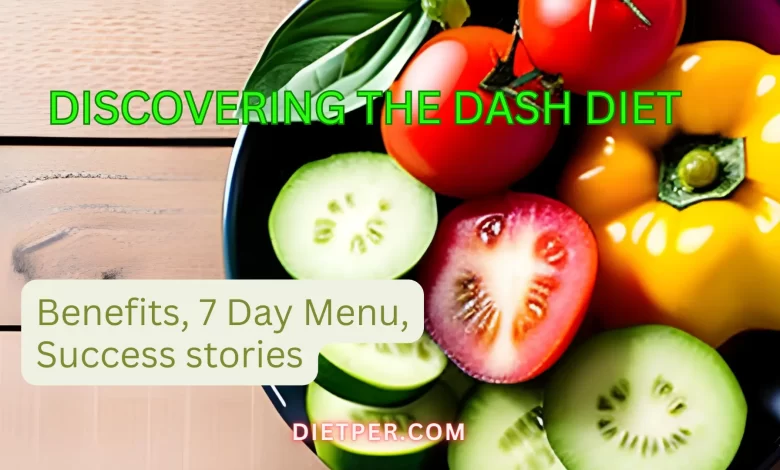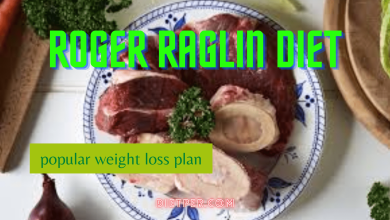DASH Diet Delights: Delicious Recipes for a Healthier You
Balancing Nutrition and Flavor: Mastering the DASH Diet

DASH Diet: In today’s world, it’s not uncommon for people to be concerned about their health and well-being. One of the most effective ways to take control of your health is through your diet, and the DASH diet is one of the most popular and well-regarded diets out there. The DASH diet reduces high blood pressure and promotes overall health and wellness.
The DASH Diet and its Benefits
The DASH (Dietary Approaches to Stop Hypertension) Diet is more than just a diet; it’s a lifestyle that promotes overall health and well-being. Created by the National Heart, Lung, and Blood Institute, the DASH Diet focuses on reducing sodium intake while emphasizing a balanced approach to nutrition.

Benefits of the DASH Diet
A Healthy Lifestyle Choice The DASH (Dietary Approaches to Stop Hypertension) Diet has gained significant popularity in recent years due to its multiple health benefits. Designed to prevent and control hypertension, this diet plan offers a holistic approach to improving overall health and well-being.
Here are some of the key benefits of following the DASH Diet:
1. Lower Blood Pressure
The primary objective of the DASH Diet is to reduce high blood pressure. With its emphasis on consuming nutrient-rich foods such as vegetables, fruits, whole grains, lean proteins, and low-fat dairy products, this diet has been discovered to lower blood pressure levels effectively. By decreasing sodium intake and increasing potassium consumption, the DASH Diet helps maintain healthy blood pressure levels, reducing the likelihood of heart disease and stroke.
2. Promotes Heart Health
As a well-balanced eating plan, the DASH Diet promotes heart health by reducing the intake of saturated fats, trans fats, and cholesterol. By focusing on lean proteins, healthy fats, and high-fiber foods, this diet helps lower LDL (bad) cholesterol levels while increasing HDL (good) cholesterol levels, thus reducing the risk of cardiovascular diseases.
3. Supports Weight Loss
The DASH Diet is not solely focused on lowering blood pressure; it is also an effective means for weight management. By emphasizing portion control, promoting whole foods, and discouraging high-calorie, processed foods, this diet encourages a balanced approach to eating, making it easier to achieve and maintain a healthy weight.
4. Diabetes Management
The DASH Diet is suitable for individuals with diabetes or those at risk of developing the condition. Encouraging a diet rich in whole grains, fruits, vegetables, and lean proteins helps regulate blood sugar levels and improve insulin sensitivity. This can assist in managing and preventing complications associated with diabetes.
5. Nutrient-Dense and Well-Balanced
The DASH Diet prioritizes consuming nutrient-dense foods, ensuring your body receives a broad spectrum of vital vitamins, minerals, and antioxidants. By incorporating a variety of food groups, this diet provides a well-balanced approach to nutrition, supporting optimal health and energy levels.
6. Flexible and Sustainable
One of the critical advantages of the DASH Diet is its flexibility, making it easy to incorporate into various lifestyles and preferences. Whether you are a vegetarian, vegan, or have dietary restrictions, the DASH Diet can be adapted to suit individual needs. With its focus on whole, unprocessed foods, this diet encourages sustainable eating habits, promoting long-term adherence and improved overall health.
One Week DASH DIET MENU
Sample Menu for One Week Following a healthy eating plan can be more accessible when you have a sample menu to guide you. If you’re looking to adopt a well-balanced diet that promotes heart health and overall well-being, the DASH (Dietary Approaches to Stop Hypertension) diet is an excellent choice. Here’s an example of a one-week DASH diet menu to help you get started on your journey toward healthier eating:

Day 1
– Breakfast: Scrambled eggs with spinach and tomatoes, whole wheat toast, and fresh berries.
– Lunch: Grilled chicken salad with mixed greens, cucumbers, bell peppers, and a light vinaigrette dressing.
– Snack: Greek yogurt with sliced almonds and a drizzle of honey.
– Dinner: Baked salmon with brown rice, steamed broccoli, and a side of roasted sweet potatoes.
– Dessert: Fresh fruit salad.
Day 2
– Breakfast: Overnight oats made with rolled oats, almond milk, and chia seeds and topped with sliced bananas and a sprinkle of cinnamon.
– Lunch: Quinoa and vegetable stir-fry with tofu.
– Snack: Carrot sticks with hummus.
– Dinner: Turkey meatballs with whole wheat spaghetti and steamed asparagus.
– Dessert: Dark chocolate squares.
Day 3
– Breakfast: Whole grain pancakes topped with Greek yogurt and mixed berries.
– Lunch: Lentil soup with a side of whole wheat bread.
– Snack: Apple slices with almond butter.
– Dinner: Grilled chicken breast with a quinoa salad (made with cucumbers, tomatoes, and feta cheese).
– Dessert: Frozen yogurt with fresh fruit.
Day 4
– Breakfast: Vegetable omelet with whole wheat toast.
– Lunch: Spinach and feta stuffed chicken breast with roasted Brussels sprouts.
– Snack: Celery sticks with peanut butter.
– Dinner: Baked cod with quinoa pilaf and steamed green beans.
– Dessert: Homemade fruit popsicles.
Day 5
– Breakfast: Berry smoothie made with almond milk, spinach, and protein powder.
– Lunch: Mediterranean salad with mixed greens, cherry tomatoes, olives, cucumbers, and a light olive oil dressing.
– Snack: Greek yogurt with granola and sliced strawberries.
– Dinner: Shrimp stir-fry with brown rice and a side of stir-fried vegetables.
– Dessert: Fresh mango slices.
Day 6
– Breakfast: Avocado toast with whole wheat bread and a side of sliced oranges.
– Lunch: Chickpea salad with tomatoes, cucumbers, red onions, and a lemon vinaigrette dressing.
– Snack: Mixed nuts.
– Dinner: Grilled tofu with quinoa and roasted vegetables.
– Dessert: Greek yogurt with a drizzle of honey and crushed walnuts.
Day 7
– Breakfast: Veggie and cheese omelet with whole wheat toast.
– Lunch: Whkikoo8hjluiiole wheat wrap filled with grilled chicken, avocado, lettuce, and tomatoes.
– Snack: Sliced bell peppers with hummus.
– Dinner: Baked salmon with quinoa as well as steamed broccoli.
– Dessert: Mixed berries with a dollop of whipped cream.
With the DASH diet and a well-planned menu, you can enjoy delicious as well as nutritious meals that support your overall health and well-being.
Does It Work for Everyone?
The DASH diet has gained popularity in recent years for its numerous health benefits, including reducing blood pressure and promoting heart health. But the question remains, does it work for everyone?
While the DASH diet has been extensively studied and shown to affect a wide range of individuals positively, it may only be suitable for some people’s specific needs or goals.
- 14 Days Challenge Diet -Transform Your Body in Just 2 week
- Sleep and Weight Gain : The Surprising Link
- 7-day Clean Eating Meal Plan – Healthy Recipes
The DASH diet focuses on consuming foods low in sodium, saturated fats, and cholesterol while emphasizing the intake of fruits, vegetables, whole grains, lean proteins, and low-fat dairy products. It is designed to be a balanced and sustainable approach to eating, promoting overall health and well-being.
However, it’s essential to consider individual factors such as medical conditions, dietary restrictions, and personal preferences when determining if the DASH diet is the right fit. For example, those with specific nutritional needs or allergies may need to modify their diet to suit their requirements.
Additionally, individuals with certain medical conditions, such as kidney disease or diabetes, should confer with a healthcare professional before adopting the DASH diet. Furthermore, adherence to any diet highly depends on an individual’s motivation, lifestyle, and willingness to make long-term changes.
While the DASH diet can be effective for many, it may not suit those who need help with food restrictions or need help adopting new eating habits.
What to Eat on the Diet?
The DASH (Dietary Approaches to Stop Hypertension) diet has gained significant popularity for its effectiveness in promoting heart health and managing blood pressure. If you’ve decided to embark on the DASH diet journey, it’s essential to understand what foods are included in this eating plan.
When following the DASH diet, you should include a range of multicolor fruits and vegetables. These can consist of berries, oranges, spinach, broccoli, carrots, and tomatoes. Not only do they add vibrant flavors and textures to your plate, but they also offer an abundance of vitamins and minerals.
Whole cereals such as brown rice, quinoa, whole wheat bread, and oats are another critical component of the DASH diet. These complex carbohydrates provide a steady release of energy and are packed with fiber, which aids digestion and helps maintain a feeling of fullness.
Lean proteins, such as skinless chicken, turkey, fish, and legumes, should also be incorporated into your meals. These protein sources are low in saturated fats, making them healthier for your heart.
Low-fat dairy products, including skim milk, yogurt, and cheese, are encouraged in moderation on the DASH diet. They provide a good source of calcium and protein while keeping saturated fats at bay. It’s important to note that the DASH diet encourages reducing sodium intake to support healthy blood pressure levels.
Therefore, limiting or avoiding high-sodium foods like processed snacks, canned soups, and salty condiments is essential. Remember, the DASH diet is not about strict restrictions but making healthier choices.
How to Make Your Diet More DASH-Like?
The DASH diet is a proven approach to improving heart health and overall well-being. If you want to adopt a healthier lifestyle and make your diet more DASH-like, here are some practical tips to get you started.
1. Increase your intake of fruits and vegetables: The DASH diet emphasizes consuming various colorful fruits and vegetables. Aim for at least five servings daily to get essential vitamins, minerals, and antioxidants.
2. Choose whole grains: Replace refined grains with brown rice, quinoa, and whole wheat bread. These options are higher in fiber and nutrients, helping you feel full and satisfied for longer.
3. Opt for lean protein sources: Incorporate lean proteins such as skinless poultry, fish, legumes, and tofu into your meals. Limit your intake of red meat and opt for healthier protein alternatives.
4. Reduce sodium intake: The DASH diet recommends limiting sodium consumption to help lower blood pressure. Read food labels, opt for low-sodium alternatives, and season your meals with herbs and spices instead of salt.
5. Include low-fat dairy products: Choose low-fat or fat-free dairy products like milk, yogurt, and cheese to meet your calcium and protein needs while keeping saturated fat intake in check.
6. Limit processed and sugary foods: Minimize your processed foods, beverages, and snacks intake. These are often high in added sugars, unhealthy fats, and sodium, which can negatively impact your health.
7. Practice portion control: Pay attention to your portion sizes to avoid overeating. Use smaller plates and bowls, and try to listen to your body’s hunger and fullness signals.
Dash diet vs Mediterranean diet
Regarding choosing a healthy eating plan, two popular options that often come up in discussions are the DASH (Dietary Approaches to Stop Hypertension) diet and the Mediterranean diet. Both of these diets have gained recognition for improving overall health and promoting weight loss.
The DASH diet focuses on lowering blood pressure and reducing the risk of heart disease. It emphasizes consuming fruits, vegetables, whole grains, lean proteins, and low-fat dairy products. The DASH diet also recommends limiting sodium intake, sweets, and sugary beverages. By following the DASH diet, individuals can benefit from reduced blood pressure levels and improved cardiovascular health.
On the other hand, the Mediterranean diet is inspired by the traditional eating patterns of people living in countries bordering the Mediterranean Sea. This diet emphasizes consuming fruits, vegetables, whole grains, legumes, nuts, seeds, and healthy fats like olive oil.
Success stories of the DASH diet
The DASH (Dietary Approaches to Stop Hypertension) diet has been widely studied and recognized for its positive effects on blood pressure and overall health. Here are some success stories and examples of individuals who have benefited from following the DASH diet:

Sarah’s Weight Loss Journey
Sarah, a 35-year-old woman, struggled with obesity and high blood pressure. She decided to adopt the DASH diet and committed to follow it strictly. Over a year, she lost 50 pounds, and her blood pressure significantly improved. She maintained her healthy eating habits and has since enhanced her weight loss and overall health.
John’s Heart Health Transformation
John, a 50-year-old man, had a family history of heart disease and was diagnosed with hypertension. His doctor recommended the DASH diet to help manage his blood pressure and improve his heart health. After several months of following the DASH diet and incorporating regular Exercise, John’s blood pressure lowered to a healthy range, and he reported feeling more energetic and focused.
Mary’s Cholesterol Reduction
Mary, a 45-year-old woman, had high cholesterol levels and was at risk of developing cardiovascular disease. She decided to try the DASH diet to improve her lipid profile. After several months of adhering to the diet and making other lifestyle changes, Mary’s cholesterol levels decreased, and her doctor was pleased with her progress.
James’ Diabetes Management
James, a 55-year-old man with type 2 diabetes, struggled to control his blood sugar levels despite medication. He decided to follow the DASH diet, which emphasizes whole grains, fruits, vegetables, and lean proteins while limiting processed foods and added sugars. With the DASH diet and regular blood sugar monitoring, James could stabilize his blood sugar levels and reduce his dependence on diabetes medication.
Conclusion
In conclusion, embracing a healthier lifestyle with the DASH Diet can be a transformative experience for your body and mind. By incorporating the principles of this diet into your daily routine, you are nourishing your body with nutrient-rich foods and taking proactive steps to prevent chronic diseases and improve your overall well-being.
Frequently Asked Questions
Can I Drink Coffee on the DASH Diet?
Yes, When you are following the DASH (Dietary Approaches to Stop Hypertension) Diet, you may wonder if you can still enjoy your daily cup of joe.
Do I Need to Exercise on the DASH Diet?
No, Exercise is still a crucial component of maintaining overall health and maximizing the benefits of the DASH Diet.
Can I Drink Alcohol on the DASH Diet?
If you’re following or considering the DASH diet, you might wonder whether you can still enjoy an occasional alcoholic beverage. While the DASH diet doesn’t expressly prohibit alcohol, it is essential to consume it in moderation and make mindful choices.
Is milk a DASH diet?
Yes. Milk, particularly low-fat or fat-free milk, is a staple in the DASH diet. It is an excellent source of calcium, vitamin D, and other essential nutrients that support overall health.
What fruit is good for the DASH diet?
When it comes to the DASH diet, which stands for Dietary Approaches to Stop Hypertension, including a variety of fruits is a crucial component. Not only are fruits delicious and refreshing, but they also provide essential nutrients that support a healthy lifestyle. So, what fruits are suitable for the DASH diet?
1. Berries
2. Citrus fruits
3. Bananas
4. Apples
5. Kiwi
6. Grapes
Remember to consume fruits in their whole, unprocessed form to reap the maximum benefits they offer.
Disclaimer: The information provided is for educational purposes only and is not a substitute for professional medical advice. Always consult a dietician/healthcare professional before making any changes to your treatment plan.




